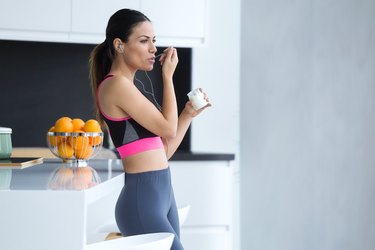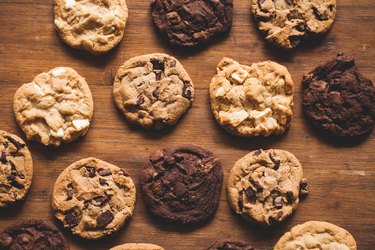
First thing's first, let's set the record straight: There isn't a magical food that can instantly give you a raised tush or toned backend. When we eat something, it doesn't make its way to specific parts of our bodies — but Melissa Nieves, RD, reassures us that good nutrition is at the cornerstone of any fitness goals.
"A balanced diet is one part of the equation and strength training is the other," Nieves says. "When we focus on these two areas of our health, we will gradually see sustainable results. We can't have strong, healthy muscles without regularly working them. So for a stronger butt, keep doing those squats and remember to get your necessary nutrients."
Video of the Day
Video of the Day
Your diet plays a big role in building muscle mass — and protein is the king of muscle food. The body breaks it down into amino acids which it uses to build muscle, according to Harvard Health Publishing.
To whip your eating habits and booty into shape, try incorporating these foods into your regimen.
Read more: 18 Best Muscle-Building Foods to Add to Your Diet
Best Foods to Eat

1. Fatty Fish
Generally speaking, protein is at the heart of any fitness quest. In fact, it should make up around 35 percent of our total calories when we are working to build more muscle, Nieves says.
Current data suggests that the daily dietary protein intake necessary to support metabolic adaptation, repair and remodeling (and for protein turnover) ranges from 1.2 to 2 grams per kilogram of body weight for athletes and those who do resistance training, according to a March 2016 report in the Journal of the Academy of Nutrition and Dietetics. For an active person who weighs 150 pounds, this translates to eating between 80 and 136 grams of protein per day.
Though there are plenty of options — from chicken to beef — experts recommend turning our efforts toward the sea. Or more specifically, to salmon, mackerel and tuna.
These fish are jam-packed with omega-3 fatty acids, which can help our booty-building efforts, according to Kellie McGrane, RD, nutrition expert for the Lose It! app. This high-protein food choice helps us repair after challenging our muscles and nourish our bodies with other beneficial nutrients, according to a February 2018 study published in Nutrients.
2. Greek Yogurt
When that 3 p.m. drop in energy strikes, you need something that'll carry you through the rest of the workday but won't leave you crashing. Most folks will opt for a coffee run and, perhaps, indulge in a sugar-filled treat. Instead, McGrane suggests packing Greek yogurt as your hanger warrior, due to its satiating dose of protein.
Greek yogurt is a great whole-food source of protein since it contains both fast- and slow-digesting proteins to aid in muscle recovery and growth, McGrane says. (Hello, booty!)
Read more: The 4-Week Butt Lift Challenge
3. Eggs
If you're Team Morning Workout, don't forget to load up on an egg or two before or after your fitness routine. As Nieves explains, this common breakfast food is an excellent source of bioavailable protein, which is linked to building muscle — including in our buttocks.
One egg packs 6.3 grams of protein — but don't skip the yolk: Eating whole eggs immediately after resistance exercise resulted in greater stimulation of muscle protein synthesis than egg whites alone, according to a small December 2017 study published in the American Journal of Clinical Nutrition.
In other words: you'll digest it faster, thus, feel fuller sooner and start the recovery process. What's more, eggs contain "complete" proteins, which provide the essential amino acids that our bodies need to build new proteins, per Harvard Health Publishing.
4. Plant-Based Proteins
"Protein is made up of amino acids and these are classified into essential and nonessential. We need to get the essential amino acids via our diets since our bodies cannot manufacture them on their own," says Sam Kramer, RD, a registered dietitian and senior nutrition coordinator for Kroger Health.
Meat, eggs and dairy foods are typically the most coveted protein sources because they contain all nine essential amino acids in the ratios people require — but a balanced vegetarian diet that includes plant-based protein can still assist in muscular development, according to the Academy of Nutrition and Dietetics.
So while animal protein naturally have these and plant-based proteins are often lacking them — does this mean we should skip 'em for butt gains? Kramer says nope, but we do need to combine them with a legume or grain source — like rice and beans to get the full amino acid profile.
As a bonus, legumes have added benefits: A half-cup of lentils boasts an impressive 9 grams of protein, as well as vitamins, minerals and fiber, according to the USDA. So remember, there are plenty of ways to get protein from plants — whole grains, nuts and nut butters, seeds and legumes (perhaps the richest source of plant-based protein) are all great sources.
5. Collagen-Rich Foods
Especially as we age, we start thinking about staying as youthful as we can for as long as possible. And if you want to maintain the firm booty from your youth, Kramer suggests stocking up on collagen-rich foods — including chicken, beef, pork and fish. "Collagen is the most abundant protein in our body and makes up most of our bones, joints, tendons and ligaments," he explains.
While Kramer notes there are 16 different types of collagen, the predominant types are I, II and II. Types I and III are found in fish and help promote skin health; Type II is found in chicken, beef and pork, and is tied to joint health — but also is an important piece of the booty puzzle.
Type II, specifically, can improve flexibility and functionality following exercise, Kramer says. Ultimately, collagen was shown to support recovery after hard bouts of exercise to promote sustainable growth, according to a small February 2019 study published in Amino Acids.
Additional research also found that collagen peptide supplementation in combination with resistance training may increase muscle mass and muscle strength in older people, according to a small October 2015 study in The British Journal of Nutrition.
Worst Foods to Eat

1. Added Sugar
"Added sugars" are the sugars and syrups added to foods and beverages during processing. Desserts, sodas, and energy and sports drinks are the top sources of added sugars for most Americans — and why are they a problem? Because foods with a lot of added sugars contribute extra calories to your diet but provide little nutritional value, according to the Mayo Clinic.
Though sure, everyone should enjoy a cupcake (or two) on their birthday, constantly stopping by your beloved bakery for 'just one' treat isn't doing your booty any favors. While baked goods are delicious, Nieves reminds aspiring athletes that doughnuts, cookies, cakes and pies are basically just refined flour, sugar and unhealthy fats, and thus have no nutrients that support muscle health. As much as you can, reserve these for special occasions to keep your butt goals firm.
And how about super-sweetened beverages? Nope, you don't need Gatorade after each and every workout. And nah, a glass of processed orange juice won't help you realize your dreams of a tight booty. McGrane warns against sugar-sweetened beverages like soda or fruit juice, since they are another source of rapidly-ingested sugar. These will not only leave you feeling low on energy when you arrive at the gym after a sugar crash, but they are also empty calories that can ultimately make you gain fat, she explains.
And frequently drinking sugar-sweetened beverages is also associated with type 2 diabetes, heart disease, kidney diseases, non-alcoholic liver disease, tooth decay/cavities and gout, according to the CDC — none of which will help toward your fitness goals.
Read more: 10 Foods You Don't Realize Are Packed With Sugar
2. Alcohol
When you're on a mission to tone up, move up a weight class or fit into that pair of jeans hanging out in the back of your closet, Nieves says its time to cut back on the booze.
"Alcohol consumption on a regular basis can increase inflammation in the body, as well as increasing antioxidant demands. The antioxidants that are normally used to help muscle recovery are instead used to help metabolize the alcohol," she explains.
Additionally, alcohol may negatively alter normal immunoendocrine function, blood flow and protein synthesis, which can impair muscle recovery, according to research published in July 2014 in Sports Medicine.
Other factors related to recovery, such as rehydration and glycogen resynthesis, may also be affected to a lesser extent, the researchers report. So if you're serious about boosting your butt, consider how much alcohol you're drinking on a regular basis.
- Harvard Health Publishing: “Preserve Your Muscle Mass”
- Journal of the Academy of Nutrition and Dietetics: “Position of the Academy of Nutrition and Dietetics, Dietitians of Canada, and the American College of Sports Medicine: Nutrition and Athletic Performance”
- Nutrients: “Achieving Optimal Post-Exercise Muscle Protein Remodeling in Physically Active Adults Through Whole Food Consumption”
- American Journal of Clinical Nutrition: “Consumption of Whole Eggs Promotes Greater Stimulation of Postexercise Muscle Protein Synthesis Than Consumption of Isonitrogenous Amounts of Egg Whites in Young Men”
- Harvard Health Publishing: “Getting Your Protein from Plants”
- Academy of Nutrition and Dietetics: “Building Muscle on a Vegetarian Diet”
- USDA’s My Food Data: “Lentils Mature Seeds Cooked Boiled With Salt”
- Mayo Clinic: “Mayo Clinic Minute: Chia – It’s Not Just a Pet”
- Harvard Health Publishing: “No Need to Avoid Healthy Omega-6 Fats”
- Amino Acids: “The Effects of Collagen Peptides on Muscle Damage, Inflammation and Bone Turnover Following Exercise: A Randomized, Controlled Trial”
- The British Journal of Nutrition: “Collagen Peptide Supplementation in Combination with Resistance Training Improves Body Composition and Increases Muscle Strength in Elderly Sarcopenic Men: A Randomised Controlled Trial”
- Mayo Clinic: “Added Sugars: Don't Get Sabotaged by Sweeteners”
- CDC: “Get the Facts: Sugar-Sweetened Beverages and Consumption”
- The British Medical Journal: “Association of Changes in Red Meat Consumption with Total and Cause Specific Mortality Among US Women and Men: Two Prospective Cohort Studies”
- Harvard Health Publishing: “What’s the Beef with Red Meat?”
- Sports Medicine: “Alcohol: Impact on Sports Performance and Recovery in Male Athletes”